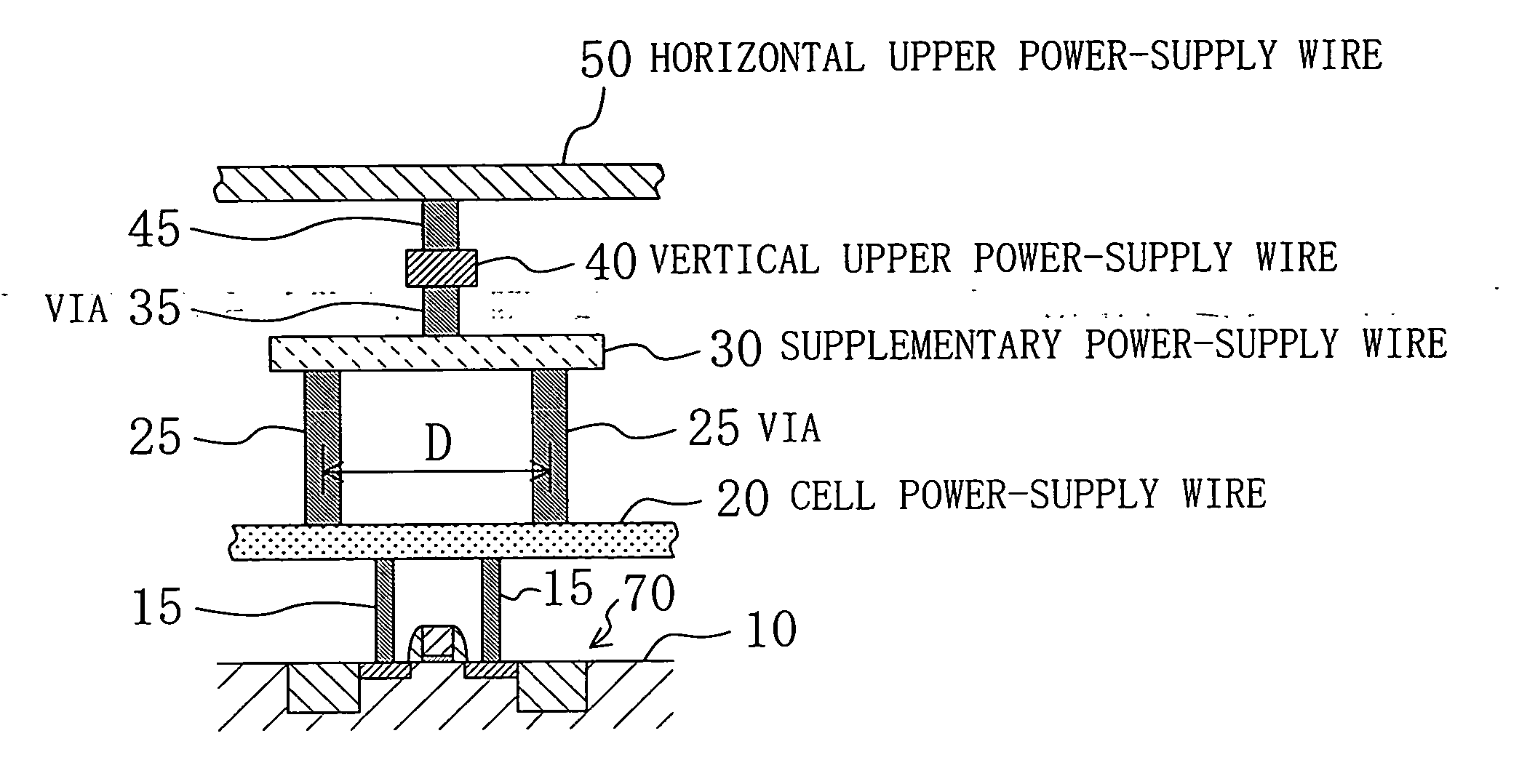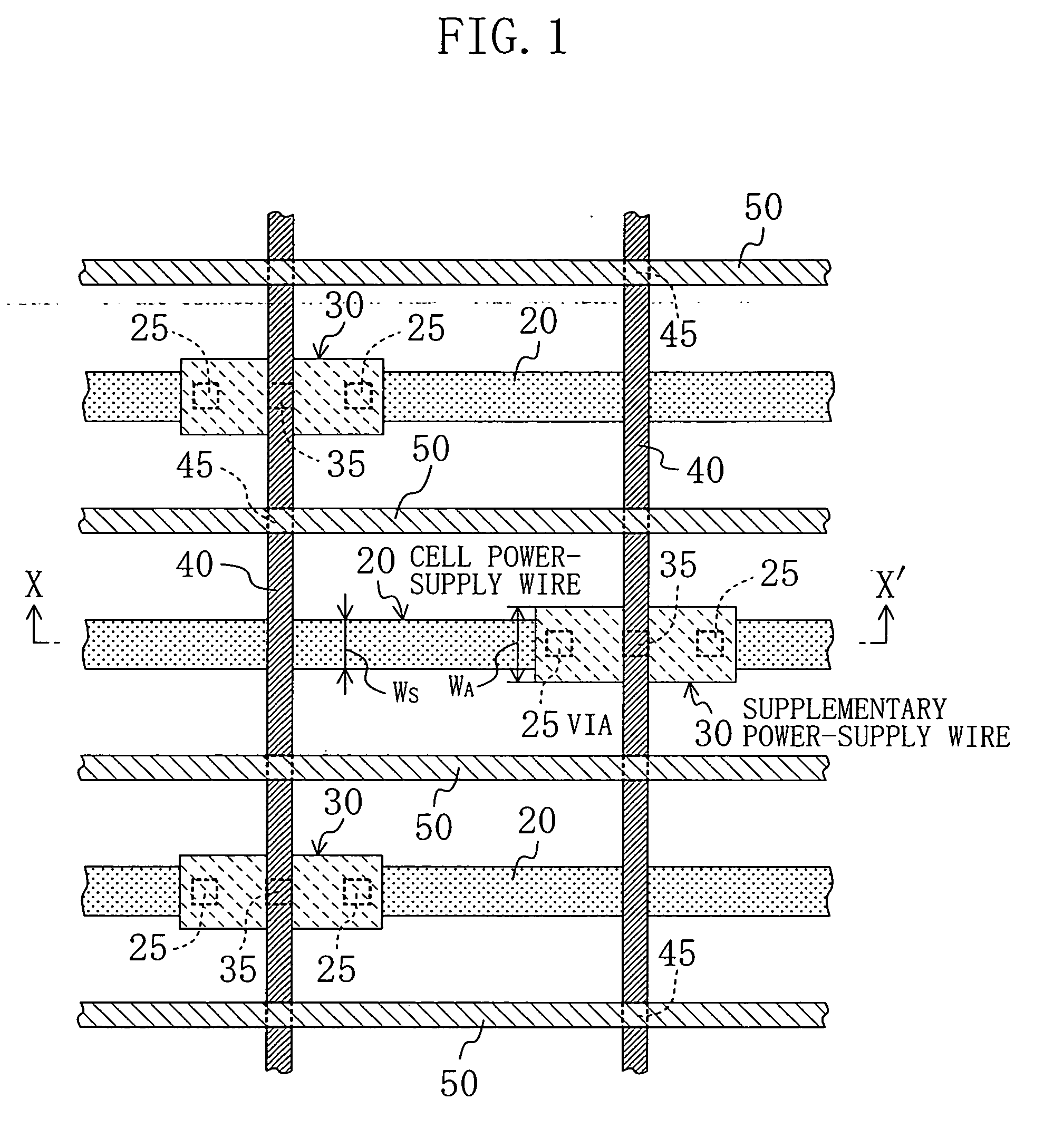Semiconductor integrated circuit
a technology of integrated circuits and semiconductors, applied in the direction of semiconductor devices, semiconductor/solid-state device details, electrical apparatus, etc., can solve the problems of reducing the operational reliability of semiconductor devices, power supply wiring becomes critical, and the problem of how to ensure signal integrity manifests itself, etc., to achieve the effect of reducing current concentration, reducing power consumption, and increasing cross sectional area
- Summary
- Abstract
- Description
- Claims
- Application Information
AI Technical Summary
Benefits of technology
Problems solved by technology
Method used
Image
Examples
first embodiment
[0045]FIGS. 1 and 2 illustrate a power-supply wiring structure in a semiconductor integrated circuit according to a first embodiment of the present invention.
[0046]FIG. 1 is a plan view of the power-supply wiring structure in the semiconductor integrated circuit. In FIG. 1, a plurality of horizontal upper power-supply wires 50, which are disposed in the horizontal direction, and a plurality of vertical upper power-supply wires 40, which are vertically disposed below the power-supply wires 50, cross each other to form a lattice as a whole. At each of their intersection points, the horizontal power-supply wires 50 and the vertical power-supply wires 40 are connected to each other by a via 45. It should be noted that the number of vias 45 used for the connection at each intersection point is not limited to one, but two or more vias 45 may be used.
[0047] As shown in enlarged dimension in FIG. 7 (but not shown in FIG. 1), below the lattice of the upper power-supply wires 50 and 40, a p...
second embodiment
[0059]FIG. 6 illustrates a power-supply wiring structure in a semiconductor integrated circuit according to a second embodiment of the present invention.
[0060] In FIG. 6, a number of horizontal upper power-supply wires 50 and a number of vertical power-supply wires 40, which are located below the horizontal upper power-supply wires 50, are provided and connected with each other at their intersection points by vias 45 so as to form a lattice-shaped power-supply wiring structure in a wide area. Supplementary power-supply wires 30 are connected to the vertical power-supply wires 40 by vias 35, wherein the number of vias 35 provided for the connection of each supplementary power-supply wire 30 is one.
[0061] Therefore, in this embodiment, when power is supplied from the upper power-supply wires 50 and 40, the amount of IR drop can be effectively restricted below a given value.
[0062] In FIG. 6, a plurality of cell ground wires 80 are disposed so that standard cells arranged in the same...
third embodiment
[0063]FIG. 7 illustrates a power-supply wiring structure in a semiconductor integrated circuit according to a third embodiment of the present invention.
[0064] The power-supply wiring structure shown in FIG. 7 is an enlarged detail view of a main part of the power-supply wiring structure of FIG. 6 surrounded by the dotted lines.
[0065] A main feature of the semiconductor integrated circuit of this embodiment is that a given distance D between two vias 25 and 25 provided for connection of a supplementary power-supply wire 30 and a cell power-supply wire 20 located below the supplementary power-supply wire 30 is determined by the number of standard cells disposed within the given distance D. As shown in FIG. 7, in this embodiment, two standard cells 60 are horizontally disposed between the two vias 25 and 25 that connect the supplementary power-supply wire 30 and the cell power-supply wire 20.
[0066] Specifically, within the cells 60, a number of semiconductor devices 70, which contri...
PUM
 Login to View More
Login to View More Abstract
Description
Claims
Application Information
 Login to View More
Login to View More - R&D
- Intellectual Property
- Life Sciences
- Materials
- Tech Scout
- Unparalleled Data Quality
- Higher Quality Content
- 60% Fewer Hallucinations
Browse by: Latest US Patents, China's latest patents, Technical Efficacy Thesaurus, Application Domain, Technology Topic, Popular Technical Reports.
© 2025 PatSnap. All rights reserved.Legal|Privacy policy|Modern Slavery Act Transparency Statement|Sitemap|About US| Contact US: help@patsnap.com



